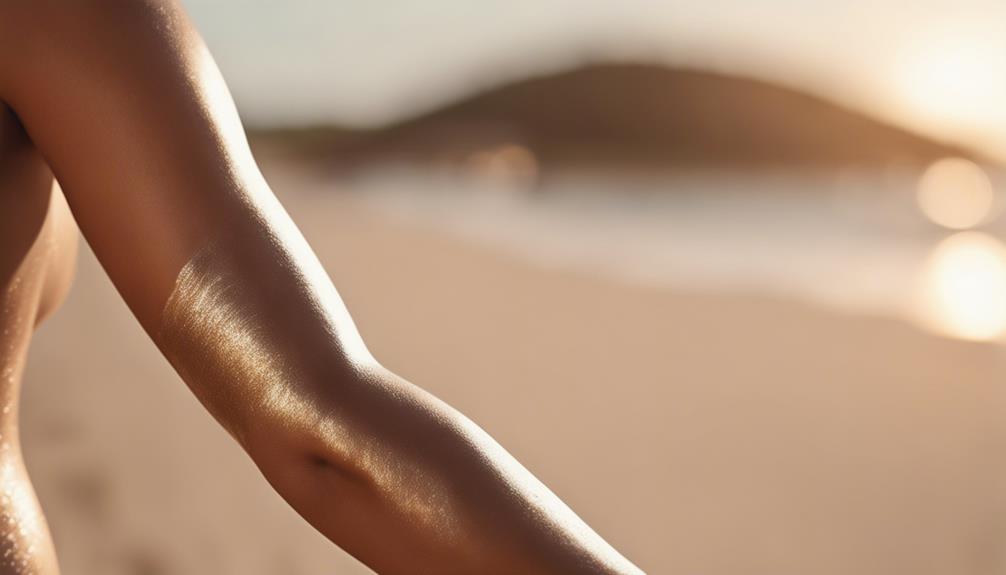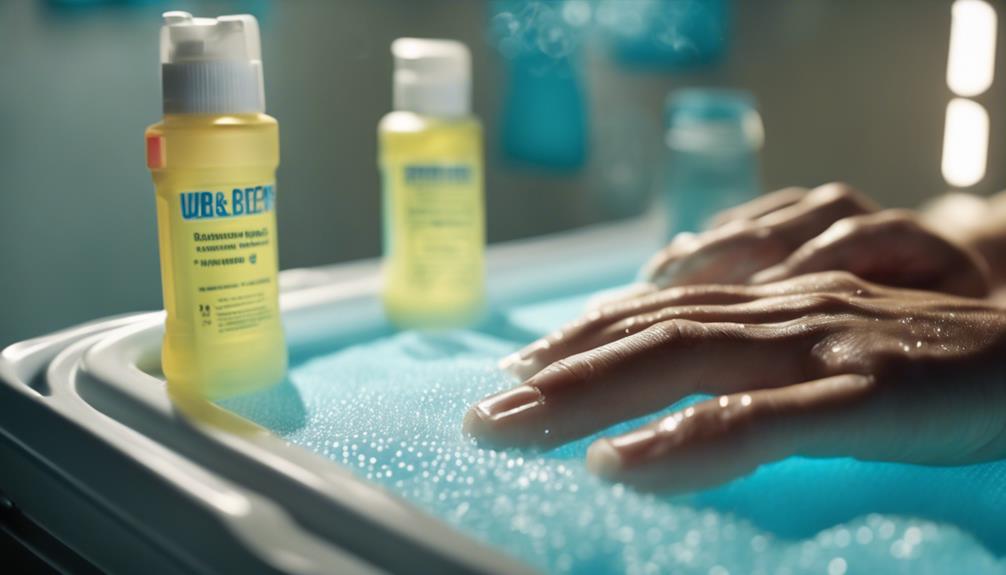To safely tan in a tanning bed, start by understanding your skin type—fair skin needs extra caution. Always consult salon experts when choosing equipment, and wear protective eyewear to safeguard your eyes from harmful UV rays. Before each session, exfoliate and moisturize with a non-oil-based lotion. Begin with short sessions of 4-6 minutes, gradually increasing the time based on your skin's reaction. Stay hydrated before and after tanning to keep your skin healthy and maintain that glow. Keep going to uncover even more essential tips for a safe and effective tanning experience.
Key Takeaways
- Always wear protective eyewear to safeguard your eyes from harmful UV rays during tanning sessions.
- Start with short sessions of 4-6 minutes, gradually increasing time while monitoring skin reactions.
- Prepare your skin by exfoliating, shaving, and moisturizing with non-oil-based products before tanning.
- Stay hydrated by drinking plenty of water before and after your tanning session to maintain skin health.
Understanding Your Skin Type
To achieve the best tanning results, it's vital to understand your skin type and its tendencies for tanning or burning.
If you have pale skin with light features, you'll likely burn quickly, so you need to be cautious. On the other hand, if you have olive or caramel tones, you can tan more easily.
Preparing your skin is also significant; shower, shave, and exfoliate at least a day before tanning to guarantee an even application. Hydrate your skin with a non-oil-based moisturizer to avoid tan lines.
Selecting the Right Equipment
Choosing the right tanning bed and equipment is essential for achieving your desired results while ensuring safety. Start by consulting salon experts who can guide you based on your skin type and preferences.
You'll want to contemplate:
- Horizontal beds for a relaxing, laid-back tanning experience.
- Stand-up booths for a quick, even tan without the need to lie down.
- Protective eyewear like tanning goggles to shield your eyes from harmful UV rays.
Tanning Bed Safety Practices
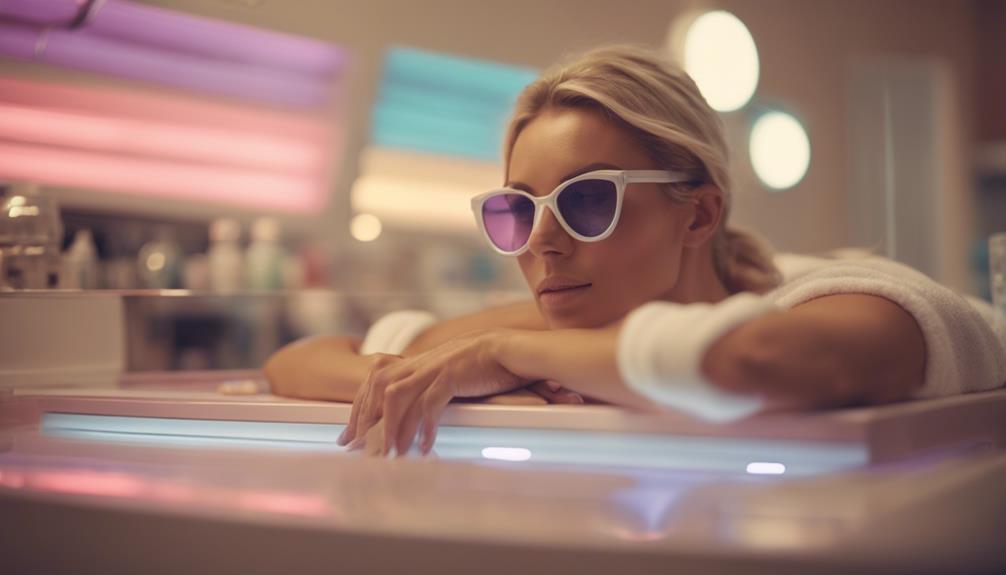
Wearing protective eyewear during your tanning sessions is essential for safeguarding your eyes from harmful UV rays.
Always adhere to recommended session times; starting with 4-6 minutes helps prevent overexposure. Gradually increase your tanning time while paying close attention to how your skin reacts. If you feel any discomfort, stop immediately.
Hydration is key, so drink plenty of water before and after tanning. Additionally, guarantee your skin is clean and free from makeup or strong scents beforehand.
Remember to consult professionals for personalized advice based on your skin type. Prioritize these safety practices to enjoy a healthy tanning experience while minimizing risks. Your skin and eyes will thank you for it!
Preparing for a Tanning Session
Preparing your skin for a tanning session is essential to achieving an even and healthy glow. Start by giving your skin some TLC a day or two before tanning.
Here's what you should do:
- Exfoliate to remove dead skin cells, ensuring a smooth base for tanning.
- Shave any unwanted hair to prevent uneven patches and irritation.
- Moisturize with a non-oil based lotion to keep your skin hydrated and ready.
Post-Tan Care Techniques
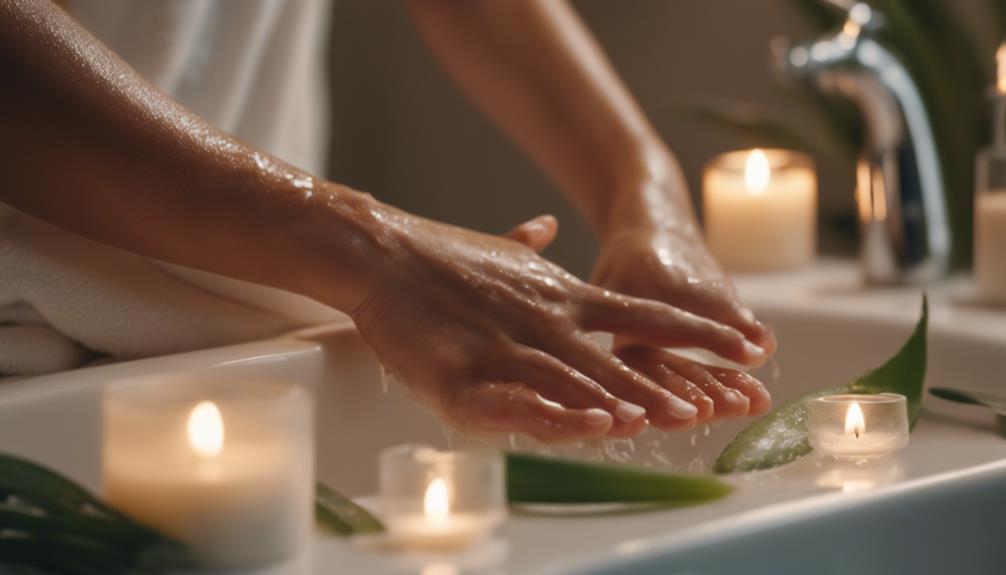
After tanning, it's important to moisturize immediately to lock in your color and keep your skin hydrated. Use a quality tan extender or a rich moisturizer that's free of harsh chemicals.
Avoid rinsing off in the shower for at least a few hours; this allows the color to set properly. If you feel sweaty, opt for cleansing wipes or an anti-perspirant spray to freshen up without washing off your tan.
Remember, hydration is key—drink plenty of water to maintain skin elasticity and vibrancy. Keep an eye on your skin's condition and adjust your aftercare routine as needed.
Choosing Tanning Bed Attire
Selecting the right attire for tanning can greatly impact your results and comfort during the session. You can choose between a bathing suit for defined tan lines or go nude for an even bronze.
Whatever you decide, comfort is key. Keep in mind that protective goggles are a must, regardless of your outfit.
Here are a few tips to enhance your tanning experience:
- Lightweight, breathable fabrics that allow your skin to breathe.
- Minimal tan lines if you opt for a swimsuit that fits well.
- Soft towels to lay on for added comfort during the session.
Hydration and Skin Health
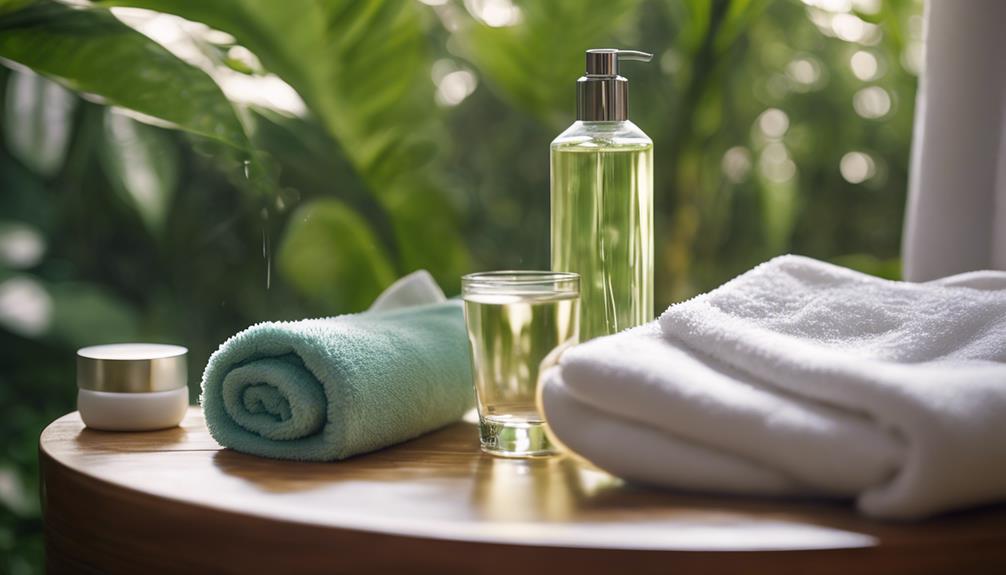
Staying hydrated is essential for maintaining skin health and achieving the best results from your tanning sessions. When you're well-hydrated, your skin retains moisture, leading to a more even and vibrant tan. Remember to drink plenty of water before and after your tanning sessions. Here's a quick guide to hydration and skin health:
| Hydration Tips | Benefits |
|---|---|
| Drink water daily | Keeps skin plump and elastic |
| Use hydrating lotion | Locks in moisture |
| Eat hydrating foods | Provides vitamins and minerals |
| Avoid alcohol | Prevents dehydration |
| Limit caffeine | Reduces water retention |
Frequently Asked Questions
How Often Can I Safely Use a Tanning Bed?
You can safely use a tanning bed 2-3 times a week, starting with shorter sessions. Always listen to your skin and adjust accordingly to avoid overexposure and potential damage. Prioritize your skin's health!
Can Tanning Beds Cause Skin Cancer?
'All that glitters isn't gold.' Yes, tanning beds can increase your risk of skin cancer. It's important to understand the dangers and prioritize your skin's health over temporary color. Always practice safe tanning habits.
What Are the Signs of Overexposure to UV Rays?
When you're overexposed to UV rays, you might notice redness, swelling, or peeling skin. You could also experience headaches, dizziness, or nausea. If any signs appear, it's essential to seek shade and hydrate immediately.
Is Tanning Safe for Pregnant Individuals?
Tanning while pregnant isn't typically recommended. You should prioritize your health and your baby's safety. Instead, consider safer alternatives like self-tanners or bronzers to achieve your desired glow without the risks associated with UV exposure.
Can I Tan if I Have a Sunburn?
Studies show that tanning with a sunburn can increase skin cancer risk by 70%. You shouldn't tan until your sunburn heals; exposing damaged skin to UV rays can worsen irritation and delay recovery. Prioritize your skin's health.
Conclusion
In the quest for that sun-kissed glow, remember that safety is your best friend. By understanding your skin type and following these essential tips, you can bask in the warmth of the tanning bed without worry.
Like a gardener tending to their plants, nurture your skin with care before and after tanning. Embrace these practices, and you'll not only achieve a beautiful tan but keep your skin glowing and healthy for seasons to come.
Enjoy the glow!


